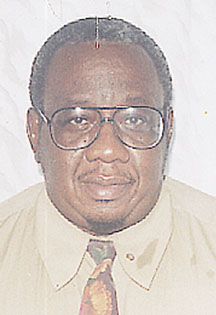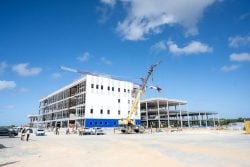President of the Guyana Manufacturers and Services Association (GMSA) Clinton Williams wants the construction industry to implement a “broad-based education and sensitisation programme” that seeks to absorb larger volumes of lesser known species of Guyana’s hardwoods into the country’s building sector.
Williams, who was recently returned as GMSA President said in a message printed in the 2013 edition of Build Guyana, published to mark this year’s International Building Expo that the abundant availability of other species of wood ought to push the building sector in that direction.
However, Managing Director of Farfan and Mendes Ltd Andrew Mendes, whose company includes a forestry concession, told Stabroek Business that the issue of the utilisation of new species of timber ought to be preceded by a review of those species that are commonly used at this time.

Alluding to what he described as “the decline of wood utilisation locally,” Mendes said the issue was not only about getting wood cheaper “through the conversion and use of lesser used/known species,” but extends to “the effective harvesting, conversion and value added carried out for existing known species.”
And according to Mendes, “it would make no sense trying to develop lesser used species in the market if the market is already not being satisfied by the existing species available. The issue is not one of species but one of wood as a whole, as a building material.”
In his statement Williams had said that the lesser known species of hardwood “are just as viable for wharves, bridges, piling and houses,” possessing properties “similar to the better-known species such as Greenheart, Purpleheart, and Kabukalli.
However, Mendes said the process of getting lesser species of timber accepted in the local building industry had to include arriving at a reliable understanding of availability in volume that would make their development a viable option.
The cost-effectiveness or otherwise of utilising some of these species would need to be assessed as well. He pointed out that it is known that some of these species have a high silica content, which can have the effect of dulling tools rapidly, leading to much higher processing costs and lower rates of production.
Additionally, Mendes said it would be necessary for lesser-known species to “have mechanical properties and durability characteristics that meet or exceed existing, known species and be suited to the end uses they are proposed for.”

Meanwhile, according to Mendes the successful promotion of lesser known species will be realised only if they are “actively promoted by the industry based on the inherent properties of the species rather than simply as a commodity.”
Williams had said that the popularisation of the lesser used species of timber required “buy-in by both the public and the private sectors, hence the need for early implementation of mandatory changes to the national standards for material specifications across the construction sector.”
Mendes, meanwhile, told Stabroek Business that “to facilitate the acceptance of lesser used species, there needs to be a building code that takes note of the mechanical properties of our species, coupled with a sensitisation programme to educate architects, engineers and eventually end users on the properties and benefits of our different species.
Until the industry improves the quality of their product, the efficiency of conversion and reliability of supply to truly satisfy the customer I do not see anything changing. Sustainable forest management is a journey and not a destination.”





